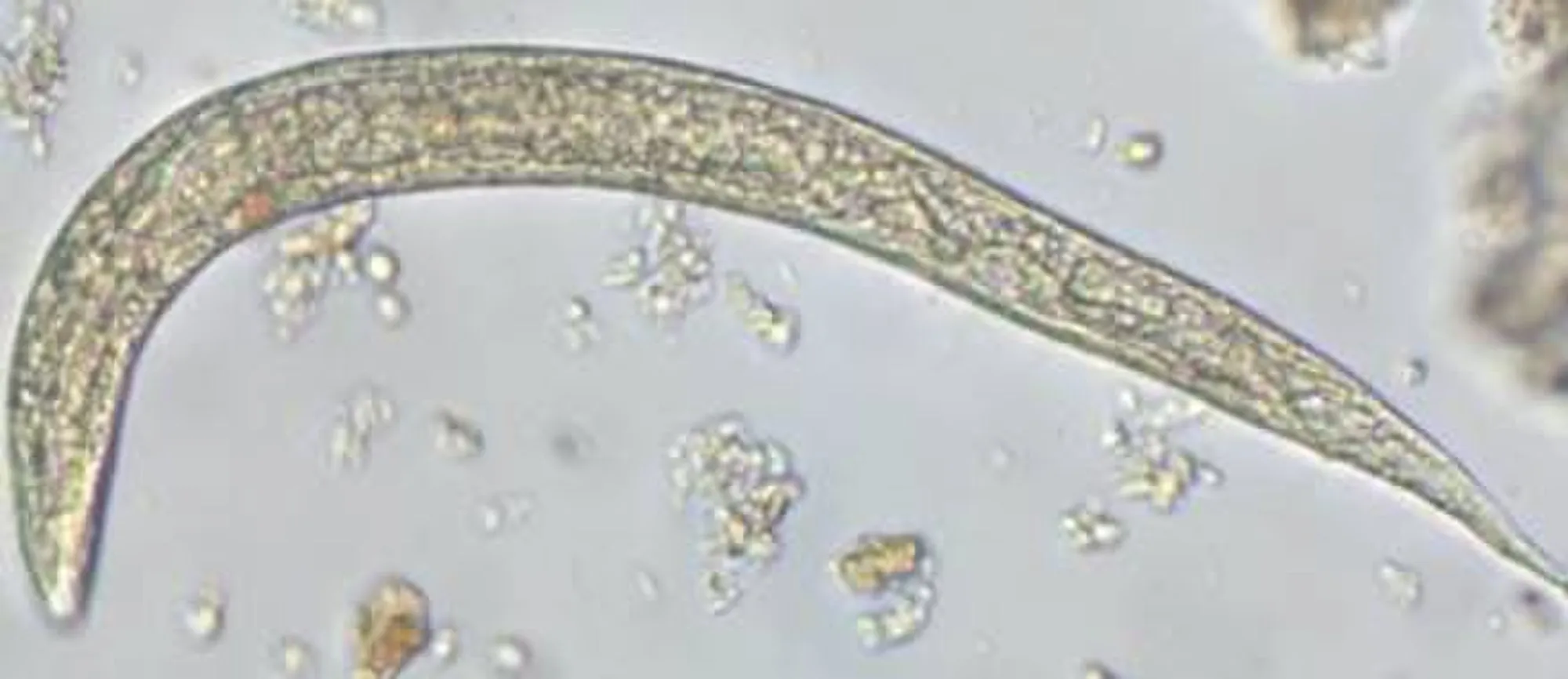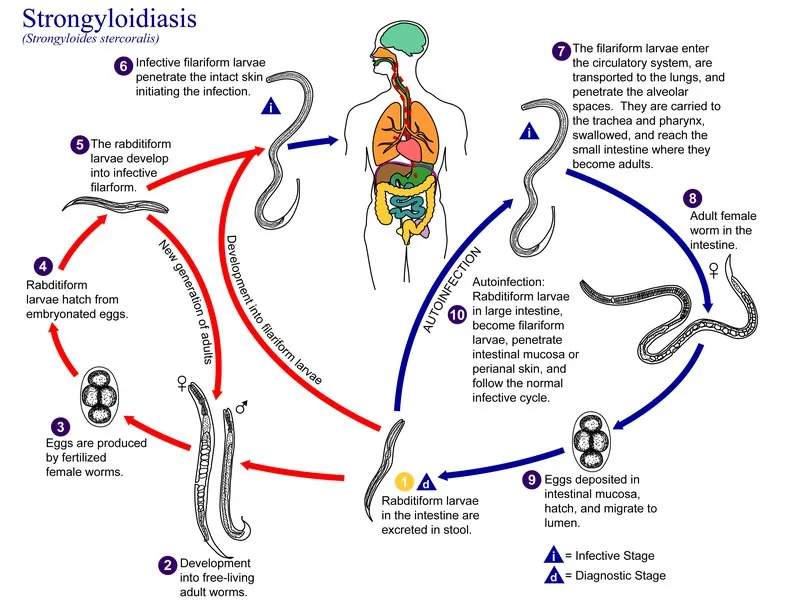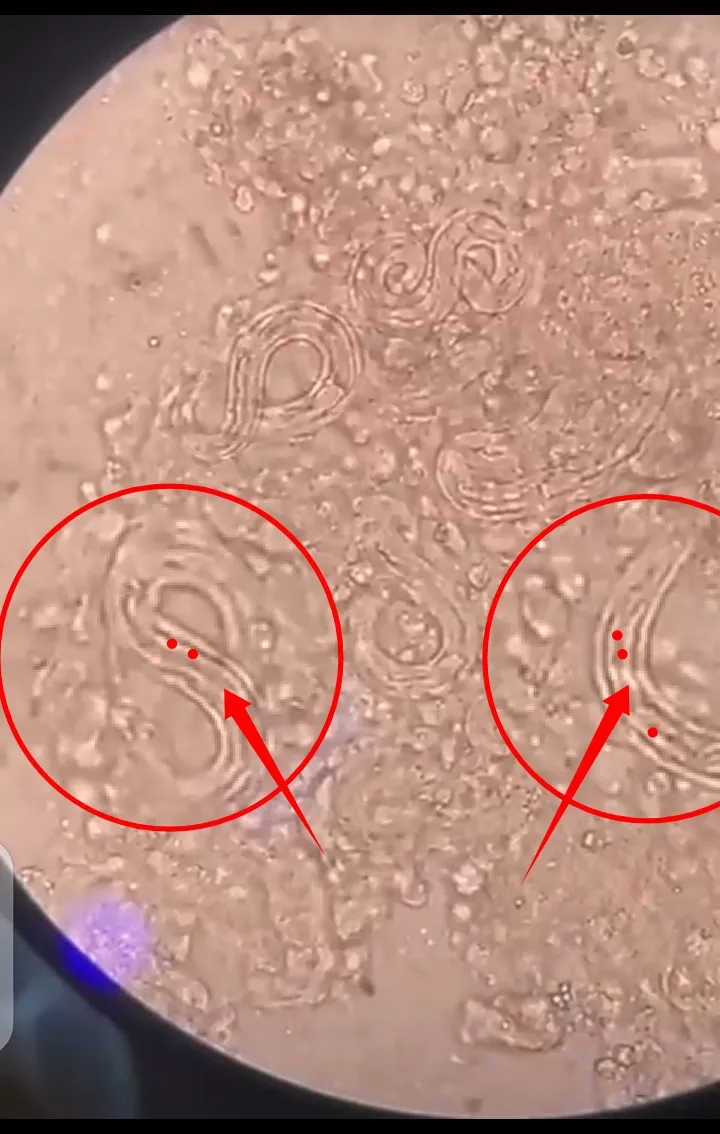Welcome to another interesting episode of our workshop and discoveries, where we bring you exclusive images about some parasites you may have not seen before now. As usual, we will do a quick introduction to what the parasite we want to discuss is all about and also go a little further to explain one or things about their diagnosis, treatment and prevention.
Watching live videos of this parasite makes you understand how they really look like, so since this parasite is motile, there is no better than to make a short video of them. I always add this videos at the latter end of the workshop series so that you can appreciate it. Ride with me as I explore the world of Strongyloides stercoralis aka Pin worm. Let's briefly look at this parasite.
Introduction
Strongyloides stercoralis is a very complicated worm that happens to undergo what is refered to as alternation of generations during its life cycle. This alternation of its generation is a very important phenomenon that must occur for the worm to successfully complete its life cycle. Its primary host is humans and it dwells mostly in the intestinal tract. The big question is, how does this parasitic worm infest humans?
 Rabditiform Larva of Strongyloides stercoralis
Rabditiform Larva of Strongyloides stercoralis
Infection with strongyloides stercoralis begins with infective form of this worm called Filariform larvae. In an infected person with strongyloides stercoralis, the larvae of this worm are usually passed out or released during stooling or defecation. This larvae is a major determinant of the parasite longevity. This Rabditiform larvae has three major pathways it can follow to continue the life cycle.
The first pathway aka free living cycle occurs in the environment and it involves the development of the Rabditiform larvae into a male and female adults that are capable of mating. Mating between this two leads to the fertilization of the female adult which in turn produces eggs that overtime hatch to release another Rabditiform larvae that is capable of fertilizing the parent larvae to produce more eggs containing another set of embryos. This cycle is more like a loop.
The second pathway this Rabditiform larvae can follow is to undergo a direct transformation into the infective form of the parasite - Filariform larvae which is the major form that can pierce the skin of the host (humans) and penetrate to cause the diseases known as Strongyloidiasis.
The third pathway the Rabitiform larvae can follow is the Autoinfection pathway. While the 1st and second pathway happens in the external environment, the autoinfection occurs in the host. The Rabditiform larvae inside the intestine of the host could transform into the Filariform larvae and reinfect the host. This is why infection with this parasitic worm is very complex and to some extent difficult to treat.
 Strongyloides stercoralis life cycle
Strongyloides stercoralis life cycle
For infection gotten through the external environment, once Filariform larvae penetrates the victim, they enter the blood and migrate to the lungs, passing through the alveolar from where they are then transported up to the trachea and into the pharynx. Once Inside the pharynx, they unintentionally swallowed into the intestinal tracts (the small intestine to be specific) where they mature to become only adult female worm with embryonated eggs that they lay in the intestinal wall.
Note a very important thing about their life cycle, in the free living cycle, they must develop into male and female adults worms so that the female can be fertilized by the males through mating (the sexual cycle), but in their host, the adult females worm alternate their generation and undergo asexual reproduction to produce embryonated eggs that are deposited into intestine.
These eggs later hatch, thereby releasing their Rabditiform larvae which moves into the lumen of the intestinal tract. Inside the small intestine (the lumen), some of these larvas are released while the patient passes out stool, while some simply can reinfect their host by piercing the anal skin or even the intestinal mucosa and the infection cycle continues.
In a nutshell, Strongyloides stercoralis exhibit alternation of generation. In man, it is asexual reproduction while in the environment, it undergoes sexual reproduction.
Infection with this parasite is mostly in warm water or contaminated soil. Once they come in contact with a host, they pierce and penetrate the skin to initiate the infection process.
Diagnosis
To diagnose strongyloides stercoralis infection, you basically look out for the presence of the active motile Rabditiform larvae in the stool of an infected patient. What you basically need is a parasep tube containing normal saline.
You use the turning stick to pick some quantity of the stool sample by the patient and then mix it with the normal saline and spin at low speed using the centrifuge. Spinning helps to concentrate the parasitic worms. After spinning, you decant the supernatant and then using a pasteur pipette, place a drop of the sediments on a grease free slide, add an iodine solution and cover it with a cover slip. Addition of Lugol's iodine helps to increase the contrast of the parasite.
Adjust your microscope to the X10 objective lens for focusing and then use X40 to view and examine the parasitic worms. If present, you would see some motile worms moving or forming the shape of 8 in the smear. The above is just a simple way of detecting the parasite, blood sample can also be used but it requires for professional techniques.
Results and findings
Strongyloides stercoralis belongs to the group of worms called pin worms because of the pin shape morphology they take on appearance. This is according to British classification. You would always see their sharp pointed end, hence the name pin worms.

Observe below,the shape and how they coil in the stool (fecal) sample above. You would also notice the sharp pointed end in these parasites. This is a simple indication of the presence of pin worm.
Another feature that is always obvious and very clearly seen, is their intestine. This is runs almost throughout the internal length of the worm's body as cab be seen below. The dots and arrows in the image below are all indicative of the worm's intestinal tract.

Since this parasite's larvae are motile, to appreciate them, they are better observe live. Just as I have always promise to make video of any motile organism. This is yet another video for your viewing pleasure and for learning.
It is as real as it can get. Most of these parasites are real and actually around us but we don't know. It takes beyond the human eyes to see microscopic organism. The ability of this parasitic worm to reinfect it's host makes its s very chronic disease that can go on for s very long time.
Clinical significance and treatment
The presence of a motile larvae of strongyloides stercoralis the stool of any patient is a good diagnostic marker of infection with the parasitic worm. This infection results to a disease condition known as Strongyloidiasis.
The initial sign of acute strongyloidiasis, if noticed at all, is a localized pruritic, erythematous rash at the site of skin penetration. Patients may then develop tracheal irritation and a dry cough as the larvae migrate from the lungs up through the trachea. After the larvae are swallowed into the gastrointestinal tract, patients may experience diarrhea, constipation, abdominal pain, and anorexia
The best drug of choice for the treatment of Strongyloidiasis is a drug known as Ivermectin. Treatment usually does not take much time so far the patient complies with standard protocols, if not, the chances reinfection will remain significant.
Ivermectin works by causing paralysing the parasitic worm. This it does by blocking the chloride channel gate in the worm so that contraction is prevented. Once their muscles are inhibited, they can move feed etc. hence, over time they die off. It is very important to keep to the prescription in order to have a very an effective treatment.
Conclusively, avoid going into dirty waters, swamp etc. with bare foots if you know that the parasite is prevalent in your community or region. These are the easiest route and ways of being infested with this parasite. Wear protective boots to protect your legs. Dogs are also potential route of infestation with this parasite. Clean up your dogs and yourself after interaction. Above all, ensure you have a proper channel of sewage disposal and fecal disposal. Doing all this will help prevent against this parasite.
References •The Laboratory Diagnosis and Follow Up of Strongyloidiasis: A Systematic Review •Ivermectin versus albendazole or thiabendazole for Strongyloides stercoralis infection •Parasites - Strongyloides •Management of Strongyloides stercoralis: a puzzling parasite •Strongyloidiasis
Return from Medical laboratory workshop Episode 4: The human parasitic worm - Strongyloides stercoralis motile Rabditiform larvae caught live to cyprianj's Web3 Blog

